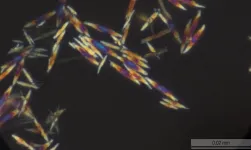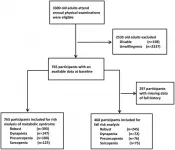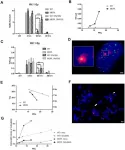Virtual lab finds the right AI tool for each chemistry problem
2021-03-22
(Press-News.org) Having the right tool for the job makes the job a lot easier, less expensive and faster. Chemical engineering researchers have now developed a virtual laboratory that can be used to determine the artificial intelligence (AI) tools best suited for addressing various chemical synthesis challenges in flow chemistry systems.
"Autonomous systems have tremendous potential for accelerating chemical R&D and manufacturing, but they are not in widespread use yet," says Milad Abolhasani, corresponding author of a paper on the work and an assistant professor of chemical engineering at North Carolina State University. "These systems face two kinds of challenges: finding or developing the right hardware for reliable, reproducible automated synthesis; and finding or developing the right 'brain,' or AI-guided decision-making algorithm, for efficiently determining the best way of synthesizing the desired material. My team focused on the hardware challenges with our Artificial Chemist project. The work we're publishing now is focused on addressing the autonomous decision-making challenges."
Abolhasani's work stems from his observation that: A) there are a lot of different AI tools available; B) it's not always clear which tool is the best fit for any given material synthesis problem; and C) whichever tool is selected, it will always need to be fine-tuned based on the chemistry problem.
"Recently, there has been increased interest in using off-the-shelf AI programs for modeling and optimization of chemical reactions," Abolhasani says. "But those off-the-shelf AI techniques are not one-size-fits-all - they're not all equally good at solving whatever material synthesis problem you want to address.
"Ultimately, we want to find the best AI model architecture for determining the best material formulation that gives you the target properties you are looking for. Not just identifying the best material, but the best way of producing that material so that it has the best possible combination of characteristics. And the best AI model architecture is going to vary depending on the material and the complexity of the challenge."
So Abolhasani and his collaborators took an AI-driven approach to finding the best AI tool for each material synthesis problem.
"It would be impossible to do the millions of experiments necessary to determine which AI tools do the best job for addressing different kinds of material synthesis problems," Abolhasani says. "So, we wanted a model that simulates a real-world microfluidic experimental platform to effectively run those millions of experiments for us."
The researchers ran 1,000 experiments using their automated Artificial Chemist platform and used those experimental data points to train the virtual experimental platform.
For the work reported in the new paper, the virtual laboratory simulated more than 600,000 experiments, assessing more than 150 AI-guided decision-making strategies. If those experiments were run in the real world, even using automated systems and microscale volumes of material, the experiments would have taken 7.5 years of continuous robotic operation and 400 liters of reagents. Abolhasani's team did it in about a month.
"We've effectively trained our virtual lab to choose the best AI tools for each material synthesis challenge," Abolhasani says. "And those tools become more efficient every time we use them, helping us resolve increasingly complex challenges in chemistry and chemical engineering. Ultimately, we think that these AI-driven tools will be able to operate quickly enough to adjust operations as needed in real time."
INFORMATION:
The paper, "Accelerated AI development for autonomous materials synthesis in flow," is published in the journal Chemical Science. First author of the paper is Robert Epps, a postdoctoral researcher at NC State. The paper was co-authored by Amanda Volk, a Ph.D. student at NC State; and Kristofer Reyes, an assistant professor of materials design and innovation at the University at Buffalo.
The work was done with support from the National Science Foundation, under grants 1902702 and 1936527; the UNC Research Opportunities Initiative; and North Carolina State University.
ELSE PRESS RELEASES FROM THIS DATE:
2021-03-22
Scientists from MIPT and ITMO University and their colleagues have studied the formation and growth of crystals from simple organic molecules into large associations. These experiments will help create capsules for targeted drug delivery to specific tissues in the human body. The scientific paper was published in the journal Crystal Growth & Design.
Melamine cyanurate consists of melamine, colourless crystals, and cyanuric acid, whose molecules associate in a similar way to DNA formation. The various studies associated with it could be useful ...
2021-03-22
COLUMBUS, Ohio - As psychedelics gain ground as a potential therapy for mental health disorders, there remains a pressing concern that patients in clinical trials may have adverse effects to the drugs.
New research identifies personality traits that have been associated with positive and negative experiences on psychedelics in previous studies, information that could help predict how future clinical trial participants will respond to the drugs.
The findings suggest that people more open to new experiences and willing to surrender to the unknown may be best positioned to have a positive experience on psychedelics, and individuals who tend to be preoccupied or apprehensive could be more likely to have a ...
2021-03-22
ITHACA, N.Y. - As the COVID-19 pandemic took hold in 2020, the list of things people could not do grew increasingly long.
But while going to the office, attending live events and gathering with large groups of friends became difficult or impossible, other activities grew in popularity - including online learning.
Drawing on records from DataCamp, an online platform tailored toward programming skills, a research team at Cornell University and Arizona State University used U.S. states' staggered adoption of nonessential business closures (NBC) to estimate their effects on the demand for online learning. The gradual closure of businesses across the U.S. gave the researchers a way to make a case for the cause and effect of NBC on increased engagement with the DataCamp ...
2021-03-22
Aging-US published "Impact of adiposity on muscle function and clinical events among elders with dynapenia, presarcopenia and sarcopenia: a community-based cross-sectional study" which reported that low muscle function determined unfavorable clinical outcome than low muscle mass; nevertheless, comparison of detrimental parameters among dynapenia, presarcopenia and sarcopenia was sparse.
The authors hypothesized that adiposity is implicated in low muscle function related adverse events.
Associations of different obesity parameters, metabolic syndrome and fall among the groups were analyzed.
Among 765 participants, ...
2021-03-22
The COVID-19 and Cancer Consortium (CCC19) published new findings in the Annals of Oncology, showing heightened mortality and racial disparities for patients with cancer diagnosed with SARS-CoV-2 infection.
After reviewing detailed information from almost 5,000 patients with active or past cancer and laboratory-confirmed COVID-19 diagnosis, CCC19 study authors found associations among laboratory measures, clinical factors -- including older age, hematological malignancy and recent chemotherapy - and poor clinical outcomes. Of the patients in the study with COVID-19 ...
2021-03-22
Aging-US published "Functional analysis of POLD1 p.ser605del variant: the aging phenotype of MDPL syndrome is associated with an impaired DNA repair capacity" which reported that Mandibular hypoplasia, Deafness and Progeroid features with concomitant Lipodystrophy define a rare systemic disorder, named MDPL Syndrome, due to almost always a de novo variant in POLD1 gene, encoding the DNA polymerase δ.
A decline of cell growth, cellular senescence and a blockage of proliferation in G0/G1 phase complete the aged cellular picture.
Moreover, the rate of telomere shortening was greater in pathological ...
2021-03-22
Researchers at the DZNE (Germany), at Massachusetts General Hospital (USA) and at the genomic medicine company Sangamo Therapeutics, Inc. tested a novel gene regulation approach to treat brain diseases such as Alzheimer's in laboratory studies. It leverages zinc finger proteins, which specifically bind to the DNA that codes for the protein Tau without altering it, thereby reducing Tau production in the brain and preventing nerve damage. The preclinical results, published in the journal Science Advances, could lay the foundation for new therapies.
The Tau ...
2021-03-22
The efficacy of biosensors used in clinical tests depends critically on the surface of the device on which the biorecognition molecules are immobilized. This surface can be adjusted and sometimes controlled using self-assembled molecular monolayers as matrices. The monolayers are films made up of organic molecules that under the right conditions assemble spontaneously on metal surfaces via chemical bonds between the sulfur atoms and the metal.
A study conducted at the University of São Paulo's São Carlos Physics Institute (IFSC-USP) in Brazil compared the performances of two types of self-assembled ...
2021-03-22
Myelodysplastic syndrome (MDS) is a disease of the stem cells in the bone marrow, which disturbs the maturing and differentiation of blood cells. Annually, some 200 Finns are diagnosed with MDS, which can develop into acute leukaemia. Globally, the incidence of MDS is 4 cases per 100,000 person years.
To diagnose MDS, a bone marrow sample is needed to also investigate genetic changes in bone marrow cells. The syndrome is classified into groups to determine the nature of the disorder in more detail.
In the study conducted at the University of Helsinki, microscopic images of MDS patients' bone marrow samples were examined utilising an image analysis technique based ...
2021-03-22
Greenwood, SC (March 22, 2021) - A research team at the Greenwood Genetic Center (GGC) has identified the mechanism that causes movement disorders in patients with mutations in the NUS1 gene. Using both cellular and model organism studies, cholesterol accumulation was found to contribute to the symptoms of seizures, ataxia, and movement abnormalities. This breakthrough study on NUS1, a gene that has also been potentially linked to Parkinson's Disease, is reported in the current issue of Genetics in Medicine, the Journal of the American College of Medical Genetics and Genomics.
Chloe Murphy, 15, of Bluffton, SC began experiencing tremors at age three. Through the years she has also experienced seizures, atypical eye movements, learning delays, ...
LAST 30 PRESS RELEASES:
[Press-News.org] Virtual lab finds the right AI tool for each chemistry problem




